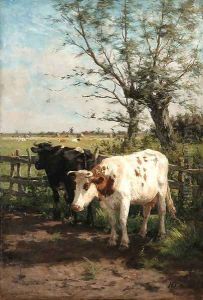Hermanus Gerhardus Wolbers Paintings
Hermanus Gerhardus Wolbers was a Dutch painter and printmaker, born in 1823 in Amsterdam, the Netherlands, during a period of rich artistic expression that included the Romantic movement. Little is known about his early life and training, but it is clear that he developed a keen interest in art at a young age.
Wolbers worked primarily as a landscape painter, capturing the idyllic rural scenes of the Dutch countryside. His style was characterized by a meticulous attention to detail and a love for the natural world. He was particularly adept at depicting the changing seasons and the various times of day, masterfully rendering the effects of light and atmosphere in his works.
As was common for many artists of the period, Wolbers traveled around the Netherlands to find inspiration for his paintings, often choosing tranquil scenes that portrayed the peaceful coexistence of nature and the rural inhabitants. His works typically featured lush greenery, waterways, and the traditional windmills that dot the Dutch landscape, executed with a precision that highlighted the beauty of his homeland.
Throughout his career, Wolbers did not achieve the same level of fame as some of his contemporaries. However, he was appreciated by art collectors and enthusiasts who sought the serene and picturesque qualities that his paintings offered. His works were exhibited in various art shows and galleries, and he contributed to the visual documentation of the 19th-century Dutch landscape.
Hermanus Gerhardus Wolbers passed away in 1889, leaving behind a modest but meaningful body of work that continues to be appreciated by those who value the traditions of Dutch landscape painting. His art provides a window into the pastoral beauty of the Netherlands during a time of great cultural and artistic achievement.
